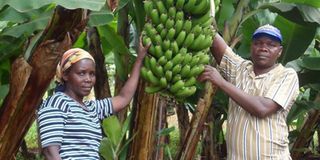Switching from miraa was the best decision

Francis Mugo and his wife in their farm in Embu County. PHOTO | FELIX MUGENDI |
What you need to know:
- Francis Mugo switched from miraa to banana farming in 2010.
- When you visit his banana farm in Embu County, ensure you carry a notebook and a pen to jot tips on farming bananas.
Miraa farmers in Embu and Meru counties are currently facing huge losses following the ban of the stimulant in Britain.
Prices of the crop have plummeted to the lowest level, with a kilo that used to go for up to Sh2,000 now retailing at Sh200.
A good number of farmers are now contemplating uprooting the crop that has in the past been a cash cow, while others are clinging on hope.
Amid this state of despair, Francis Mugo is counting himself lucky.
Mugo switched from miraa to banana farming in 2010, and going by what is happening to miraa farmers currently in the region, he believes he made the best decision.
“Until I ventured into banana farming, I had nothing to show from my toil as a farmer for six years. Miraa had good prices, but this depended with the season. Sometimes we could sell a kilo at Sh2,000, then it would drop to less than Sh100 when there was glut,” says Mugo, who had 500 miraa stems that he uprooted gradually.
PRUNING TIPS
When you visit his banana farm in Embu County, ensure you carry a notebook and a pen to jot tips on farming bananas.
“Bananas need a lot of manure and light. To get the best yields, a farmer is supposed to start pruning immediately after the maroon flower spouts,” counsels Mugo, who has farmed his way into becoming one of the top banana farmers in the region. He now has about 400 banana stems and employs three casuals regularly.
“Prune a leaf or two each week. When they are ready, they should be having three or four leaves.”
He advises that if one prunes more than two leaves at a go or fails to prune the expected leaves on weekly basis, the crops may fail to produce the required weight and quality.
And they also fall prey to Cigar End Rot disease, which is common.
The farmer uses two wheelbarrows of well-composted manure to plant a banana shoot in a three by three feet hole.
He picked the tips from seminars organised by Kenya Agricultural Productivity and Agribusiness Project (KAPAP) in Embu.
Mugo, who is based in Kawanjara, Runyenjes, grows the Fia and Williams varieties.
“I started with 300 banana stems, which I bought at Sh120 each from a farmer in Karatina. In the first harvest, I pocketed over Sh100,000, which motivated me. I sold each banana at Sh15 a kilo”
To plant the bananas, he thoroughly mixes soil with manure, then puts in a hole, wets the mixture and then plants the shoots.
On average, his bananas weigh between 90 and 115kg when mature.
“The good thing with bananas is that they produce many shoots. Farmers can thus multiply their stock very fast,” says Mugo, who notes one of the challenges he faces is finding best prices for his produce.
WINDOW METHOD
To ensure there is enough light in his banana farm, the farmer uses the window method farming. This is where one intercrops bananas with other plants.
Anthony Gateri, Embu KAPAP coordinator, says in the window method, a farmer divides the farm into several square parts. He then grows bananas on the edges of the squares and horticultural crops on the inside.
He praises the method as ideal for farmers with small pieces of land.
Mugo sells his produce through a group known as Kawanjara Commercial Village. The farmers collect their produce and sell to a trader who ferries them to Nairobi.
“My banana venture has pushed me into dairy farming for manure. Banana leaves and stems are also food for animals so they do not go to waste after harvesting the fruits.”
Alex Kinyua, an agricultural officer based in Runyenjes sub-county, says for better harvest, one should grow four bananas in each hole in pure orchard strands method where a farmers fills the entire land with bananas.
“In a window method, a farmer can allow up to eight shoots if he is able to apply enough manure because there is plenty of space to allow sunlight.”
The officer says banana farming is not a complex venture because it is not labour-intensive while the market is guaranteed with little price fluctuations.



